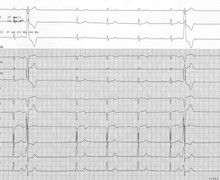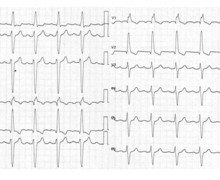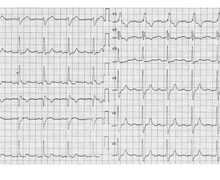T-wave oversensing
Tracing
Manufacturer Boston Scientific
Device ICD
Field Sensing
N° 8
Patient
This 75-year-old man received a single chamber defibrillator; remote monitoring alert (Latitude) for an episode of VT with aborted therapy.

Graph and trace
- sinus rhythm;
- intermittent T-wave oversensing;
- prolonged oversensing and 8 out of 10 criterion fulfilled (V-Epsd);
- end of the Duration (VF zone) and charge of the capacitors;
- PVC and undersensing of the following ventricular cycle;
- undersensing and interruption of the charge;
- 8 out of 10 criterion fulfilled; at the end of Duration, burst of stimulation (Quick Convert);
- absence of oversensing and charge diverted;
Other articles that may be of interest to you







T-wave oversensing is very infrequent in Boston Science devices. The incidence is probably much lower than with devices from other manufacturers. Many physicians following patients implanted with a Boston Science device have never observed a single case of T-wave oversensing. The band-pass filter of 20-85 Hz designed to filter out low frequency T-wave and high frequency muscle noise, the nominal sensitivity of 0.6 mV and the characteristics of the sensing circuit may be the main reasons to explain this very low rate.
The possibilities of reprogramming are limited in case of these infrequently described cases of T-wave oversensing (no possibility of reprogramming the upper threshold, the decay delay, the filters...). The only possibility is to alter the ventricular sensitivity and to verify the accurate detection of a true VF episode.